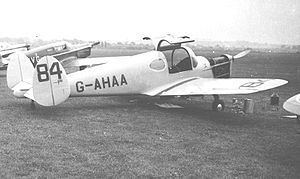Top speed 256 km/h Length 7.32 m Manufacturer Miles Aircraft | Wingspan 9.35 m First flight July 11, 1941 | |
 | ||
The Miles M.28 Mercury was a British aircraft designed to meet the need for a training and communications plane during the Second World War. It was a single-engined monoplane of wooden construction with a twin tail and a tailwheel undercarriage with retractable main units.
Contents
Development
Originally, the M.28 had been planned as a replacement for the Whitney Straight and Monarch, but this was shelved when war broke out.
In 1941, the project was revived in response to a requirement for a training and communications aircraft. The design was produced as a private venture by Ray Bournon using Miles' normal wooden construction. The resulting machine introduced several features not found on trainers: retractable undercarriage and trailing edge flaps amongst others. In the communications role, the M.28 had four seats and a range of 500 miles (800 km).
The prototype first flew on 11 July 1941 and proved easy to fly, with light controls and a short landing run. Owing to Miles' heavy commitment to war-production, however, only six aircraft were built, of slightly varying specifications, the last being the Mercury 6 which first flew in early 1946. Examples of the type were operated in the United Kingdom, Denmark, Germany, Switzerland and Australia.
Variants
Specifications (M.28)
Data from The Hamlyn Concise Guide to British Aircraft of World War II
General characteristics
Performance
